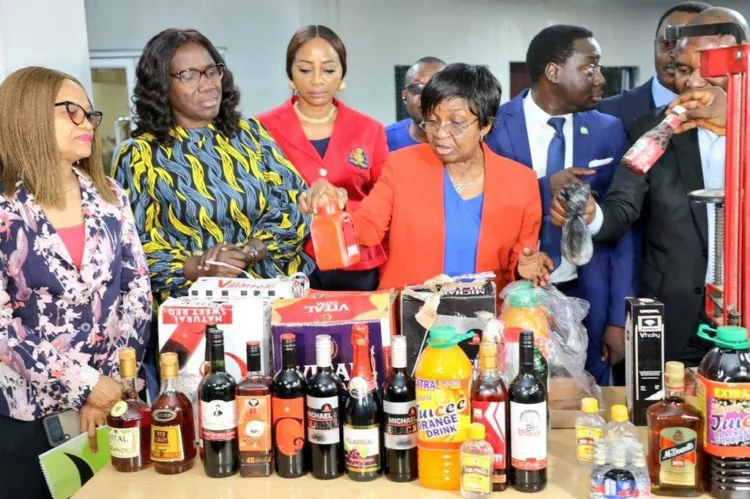9 tips to spot fake products amid widespread unapproved drinks, food items in Nigeria

“Global reports reveal a staggering toll of over three million deaths worldwide attributed to alcohol poisoning,” warns Prof Mojisola Adeyeye, Director General of the National Agency for Food and Drug Administration and Control (NAFDAC).
“In Nigeria, 10% of cancer cases and 4.7% of overall cases in 2019 were traced back to adulterated alcohol consumption.”
Adeyeye emphasizes the severe health risks associated with consuming such alcohol, ranging from nausea to kidney or liver failure. “Vigilance is crucial,” she urges, advising scrutiny of branded drinks in the wake of the alarming statistics.
Despite government efforts to enhance food safety, foodborne diseases persist as a major health concern in Nigeria. Prof Adeyeye, during a virtual media parley in Abuja, discloses a significant breakthrough in the interception of counterfeiters at Eziukwu market in Aba, Abia state.
“Counterfeiters were producing fake beverages, including wines and soft drinks,” she reveals, noting a street value of over N750,000,000 for the confiscated and destroyed counterfeit products.
In collaboration with security agencies, the operation was based on an intelligent tip-off. Adeyeye details the nefarious activities of the counterfeiters, involving the production of various adulterated products from renowned brands.
“Seaman Schnapps, Henessy, Four Cousins, Carlo Rossi, Jenney, Chelsea London Dry Gin, Schnapp Dry Gin, McDowells, Black Labels, Gordons, Martell, Campari, Smirnoff ice, Eva non-alcoholic drink, Evra non-alcoholic drink, Cartel, among others,” she lists.
The seriousness of the situation leads to the destruction of over 1,500 cartons of fake and substandard products, with an additional 300 cartons evacuated to the NAFDAC warehouse. Ten individuals are arrested, facing charges following a thorough investigation.
Prof Adeyeye underscores the gravity of the issue, resulting in the temporary shutdown of the entire market for regulatory activities until stakeholders commit to preventing such illicit practices.
She concludes with a stern warning about the severe consequences of consuming adulterated alcohol, including the potential for permanent blindness from methanol found in fake vodka.
5 ways to spot counterfeit products
Packaging details: Authentic products often have high-quality packaging with clear logos, fonts, and colors. Counterfeit goods may have spelling errors, faded colors, or poorly printed labels.
Check holograms and labels: Many genuine products include holographic labels or special seals. Counterfeiters might struggle to replicate these accurately. Examine these features closely for irregularities or lack of authenticity.
Quality of materials: Authentic products are typically made with high-quality materials. Check the item’s build, stitching, and overall craftsmanship. If something feels flimsy or appears subpar, it may be a fake.
Retailer reputation: Purchase from reputable sources. Counterfeiters often sell through less-known or suspicious channels. Verify the legitimacy of the retailer, especially when buying online.
Compare prices: If a deal seems too good to be true, it probably is. Be wary of significantly discounted items, as counterfeits are often priced attractively to lure unsuspecting buyers.
Check the packaging: Authentic products often have high-quality packaging with clear logos, consistent colors, and professional printing. Look for any signs of poor printing, misspelled words, or irregularities in the packaging.
Verify serial numbers and barcodes: Authentic products usually come with unique serial numbers or barcodes. Check for these identifiers and verify them with the manufacturer’s official database or customer support. Fake products may have generic or duplicated codes.
Examine quality and craftsmanship: Genuine products are generally well-made with attention to detail. Inspect the product for any signs of poor craftsmanship, such as uneven stitching, loose parts, or cheap materials. Flimsy construction can be a red flag.
Research authorized sellers: Purchase from authorized dealers or reputable retailers. Check the manufacturer’s official website for a list of authorized sellers. Buying from well-known and trusted sources reduces the risk of receiving counterfeit goods.
READ ALSO: Emeka Ike: How to deal with the trauma of failed marriage
Note, a combination of these factors can enhance your ability to identify counterfeit products.




